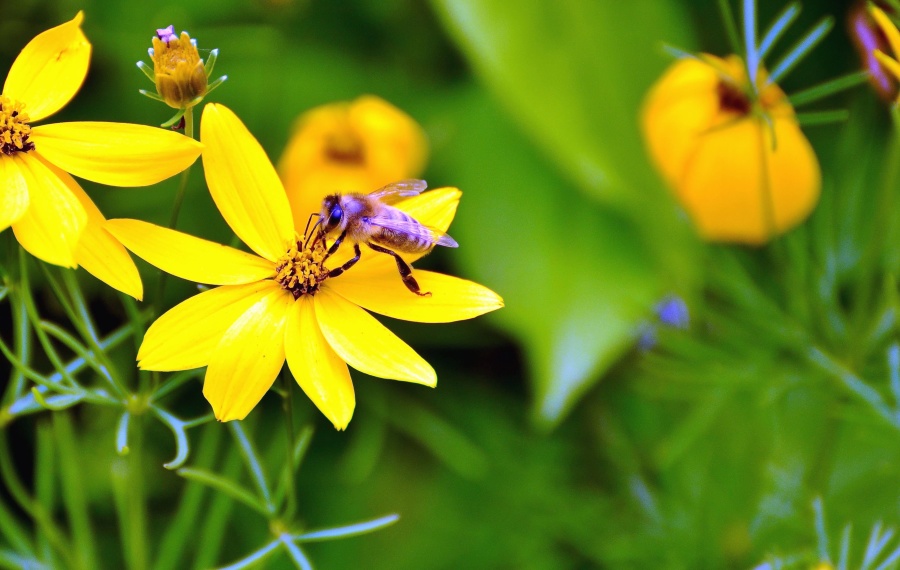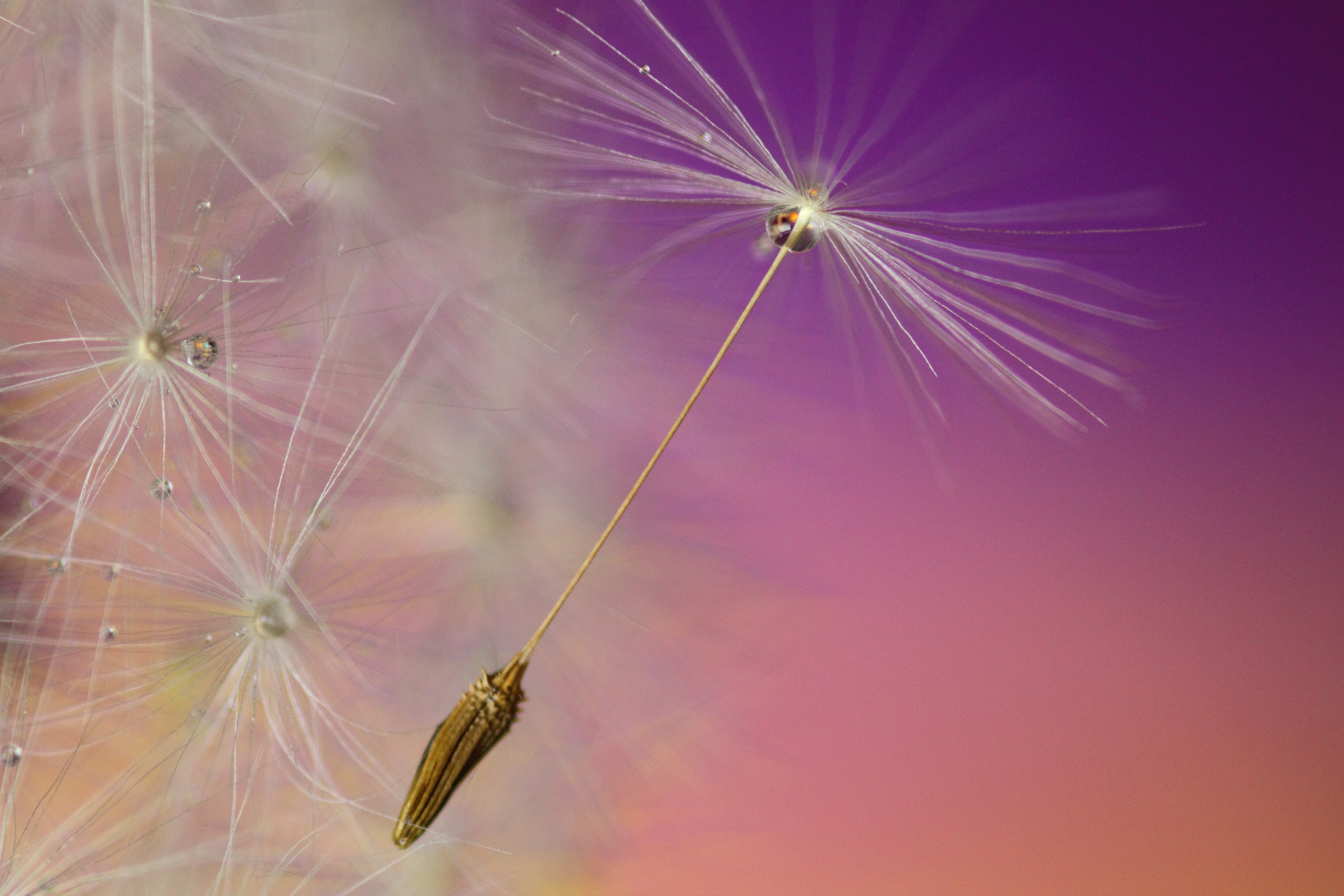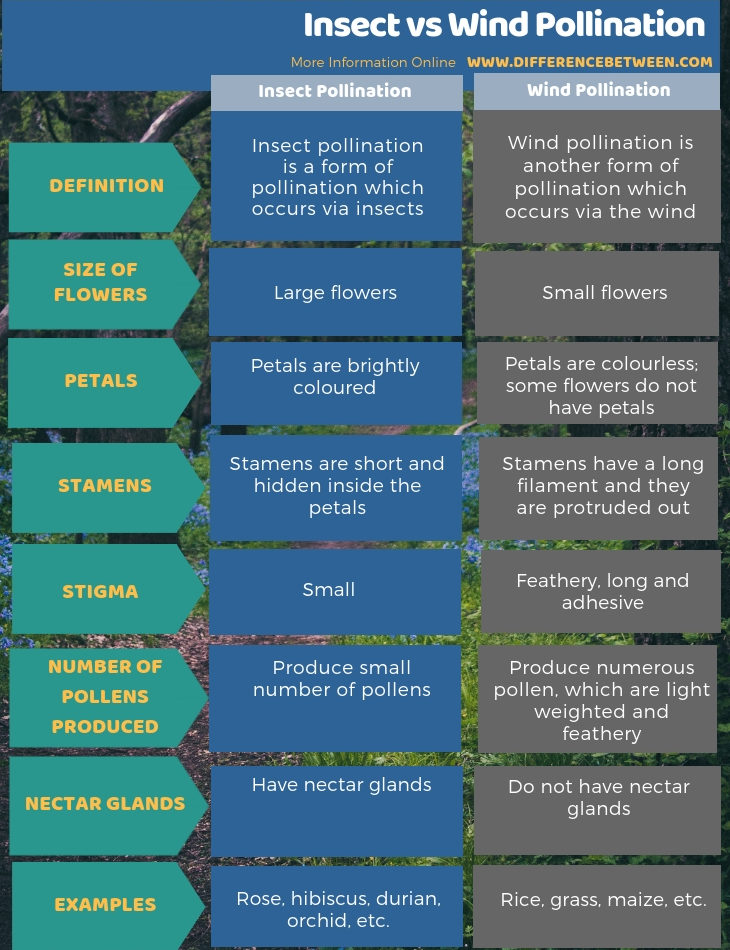The key difference between insect and wind pollination is that the plants that use insect pollination produce colourful, attractive and scented flowers, while the plants that use wind pollination produce small, dull and less attractive flowers.
Pollination is the process of transferring pollen from anthers to the stigma of a flower. There are two types of pollination; self-pollination and cross-pollination. Self-pollination occurs between an anther and the stigma of the same flower. Thus, it occurs within the same flower. Whereas, cross-pollination occurs between two flowers of the same plant or different plants of the same species. Cross-pollination is evolutionary important since it mixes the genes among plants. Pollinators or pollinating agents contribute a lot to cross-pollination in order to transfer pollen from one flower to another flower. Insects are the most fascination pollinators. Some abiotic factors such as wind and water too contribute to cross-pollination. Thus, this article discusses the difference between insect and wind pollination.
CONTENTS
1. Overview and Key Difference
2. What is Insect Pollination
3. What is Wind Pollination
4. Similarities Between Insect and Wind Pollination
5. Side by Side Comparison – Insect vs Wind Pollination in Tabular Form
6. Summary
What is Insect Pollination?
Insect pollination is a type of pollination mediated by insects. In simple words, insects carry out the transferring of pollens from anthers to the stigma of a flower. Insect pollination flowers have several characteristics that are important for the pollination by insects. Generally, insect pollinating flowers are brightly colourful. They also have a nice scent. Furthermore, the flowers are large and nicely visible. Their stamens are small and hidden inside the petals.

Figure 01: Insect-Pollinated Flower
Most importantly, insect-pollinated flowers produce nectar in order to attract insects. These flowers produce a small number of pollens, but they are sticky pollens.
What is Wind Pollination?
Wind pollination is another form of pollination, which occurs with the help of wind. Generally, wind-pollinated flowers are small and not colourful. Moreover, these flowers produce numerous pollens, which are light-weighted and feathery. Not only that, they possess stamens with long filaments. Their stigmas are large and feathery.

Figure 02: Wind-Pollinated Flower
Unlike insect-pollinated flowers, wind-pollinated flowers do not have nectar glands. They don’t have a smell as well.
What are the Similarities Between Insect and Wind Pollination?
- Insect and wind pollination are two forms of pollination.
- Both processes are important for flowering plants.
- Moreover, the flowers that engage in these pollinating methods possess unique characteristics.
What is the Difference Between Insect and Wind Pollination?
Plants that use insect pollination produce flowers that are large, colourful, fragrant and attractive, while plants that use wind pollination produce small, scentless and plain flowers. So, it is the key difference between insect and wind pollination. Furthermore, insect-pollinated flowers have nectar glands while wind-pollinated flowers do not have nectar glands. Therefore, we can consider this too as a difference between insect and wind pollination.
Besides, a further difference between insect and wind pollination is that the insect-pollinated flowers produce a small number of pollens while wind-pollinated flowers produce a large number of pollens which are feathery and light weighted.
You can find more comparisons in the below info-graphic on the difference between insect and wind pollination.

Summary – Insect vs Wind Pollination
Insect pollination and wind pollination are two forms of pollination. Insects carry out insect pollination while the wind carries out wind pollination. Generally, insect pollinating flowers are large, colourful, scented and have nectar. Whereas, wind pollinating flowers are very small and not scented. Moreover, they are not colourful and they don’t have nectar. Furthermore, insect pollinating flowers produce a small number of pollens while wind pollinating flowers produce a large number of pollens which are feathery and lightly weighted. Thus, this summarizes the difference between insect and wind pollination.
Reference:
1. “Wind Pollination.” Wind Pollination – an Overview | ScienceDirect Topics, Available here.
2. “Insect Pollination: Process, Diagram & Adaptations” Study.com, Available here.
Image Courtesy:
1. ” Bee, flower, pollen, insect, pollination, honey” (CC0) via Pixino
2. “1070875” (CC0) via Pxhere
ncG1vNJzZmivp6x7pbXFn5yrnZ6YsqOx07CcnqZemLyue8OinZ%2Bdopq7pLGMm5ytr5Wau261zaycnKxdlruledaipZ1loKS5rbXNmquip55k